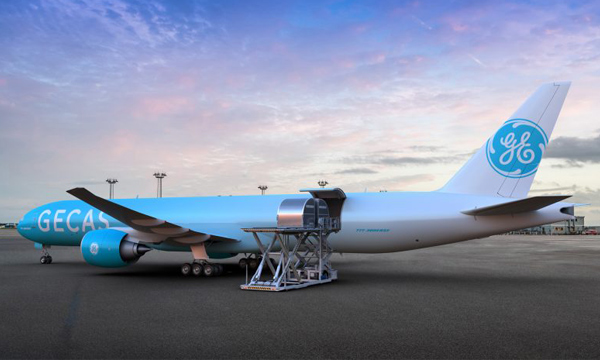The conversion programme of Boeing 777-300ERs into full-freighter aircraft will be ready in 3 years |
| Romain Guillot |
|
|
31 OCT 2019 | 303 words
|
 |
© GECAS |
|
|
|
GECAS and Israel Aerospace Industries (IAI) have launched a new full-freighter aircraft conversion programme based on Boeing's 777-300ER platform. The 777-300ERSF (Special Freighter) programme, which has already been named the "Big Twin", should come into service at the end of 2022.
The prototype, an aircraft which is currently being operated by Emirates, will be provided by the American leasing company and will be converted by IAI in Tel Aviv over a two-year period from December 2020. Later conversions will then only take between four and five months.
This is the first conversion programme for the Boeing 777 family, with the American aircraft manufacturer continuing to offer its 777 Freighter direct from the factory, the full-cargo version of its 777-200LR.
Here the 777-300ERSF is clearly targeting taking over from the 747-400F and operators who transport low volume weight freight, such as express parcel transport specialists and people involved in e-commerce.
The "Big Twin" is also positioning itself as an aircraft which integrates perfectly into the fleets of operators who already have 777 Freighters, as it has much in common with the large twin-engine freighter aircraft proposed by Boeing, in that it has the same engines (GE90-115B), the same pilot qualification, 90% of maintenance tasks in common and of course the same fuselage section, so the the ability to carry the same pallets and containers.
According to GECAS and IAI, the 777-300ERSF will burn 21% less fuel per tonne in relation to the 747-400F while offering 25% more volume than the 777 Freighter. Its range will be 4650 nautical miles (8600 km) at full payload (a maximum 101.6 tonnes of freight).
GECAS has already committed to 15 firm aircraft (including the prototype) with an option for additional 15, with all coming directly from its portfolio.
|
|
 |
Romain Guillot
Chief editor
Cofounder of Journal de l'Aviation and Alertavia
|
|
| |
They made this section possible |
|
|
|
|
|
|
|
|
|
|
|
|
|
|
|
|
Top stories |
|
|
|
|
|
Top stories
|